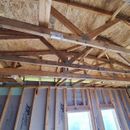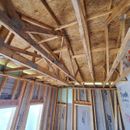Best way to insulate attic of new addition?
I have a new mud/laundry room addition to my house. I’m in central NY. It’s 12’x22′ with a hip roof built with trusses. I was wanting to use closed cell foam for the under side of the roof deck. The ceiling will be drywall. I was wondering if this would be OK? Do I need to supply any heated or cooled air to that attic area? Would a vented attic be OK instead although insulating it would be very difficult.
I’m also considering spraying the walls which are built with Zip R-6 panels. Any and all help would be greatly appreciated. Thank you.
GBA Detail Library
A collection of one thousand construction details organized by climate and house part











Replies
Hi John
Looks to me like this was designed as a standard, ventilated attic. Instead of spray foam on the roof deck and walls I would use blown in insulation like fiberglass or similar. The walls can be insulated with batts.
You will need to ensure the roof has proper ventilation, and a proper continuous air barrier is installed at the walls and ceiling.
If this is a vented attic, and I can't see enough to be sure (the telltale sign would be a ridge vent), then I'd go with loose fill insulation, probably blown cellulose. I'd use mineral wool batts in the walls, since I like to work with those, but fiberglass would work too. There is no need for spray foam UNLESS you have no way to vent the attic space. Spray foam in attics is usually reserved for one of two situations:
1- You have mechanicals in the attic (furnace, etc.), so you have to condition the space by insulating the roof
2- You have no choice but to build an unvented assembly due to soemthing like a cathedral ceiling, or possibly oddball roof intersections like you'd have with a dormer
In nearly all other attic situations, you're better off doing a conventional job of air sealing of the attic floor, then insulating the attic floor with loose fill insulation like blown cellulose or blown fiberglass, and finally venting the attic with ridge and soffit vents.
Bill
A ridge vent may not be practical on a hip roof, I would look at static vents. The manufacturer will provide actual vent sizing so you can calculate how many you need, but they should be evenly spaced and installed near the peak of the roof. Used in conjunction with soffit vents the roof should be well ventilated.
Thank you for the replies. Would I install drywall on all of the ceiling except for an area big enough to stand up and blow in the insulation? It would be very difficult to move around up there with all of the trusses.
Get thick faced batts and staple them to the underside of the trusses. Much easier than blowing in fluffy into such a small space.
The important detail for energy efficiency is ensuring air barrier continuity. For your walls it is easy and you have done 99% of that with the taped Zip.
You need to now connect this to your ceiling somehow. I would install blocking between the trusses above the wall plates (ie if 2x4 wall, install 2x6 blocking so it overhangs to the inside). Either tape this blocking to the sheathing on the outside or cover with one of the smaller spray foam kits. Install the batts. Now you can seal the drywall to the blocking with acoustic sealant to complete the air barrier.
Also make sure to seal the Zip to the foundation (tape or liquid flash) as well as this tends to be a big air leak as well.
>"Get thick faced batts and staple them to the underside of the trusses. Much easier than blowing in fluffy into such a small space."
While it's more work to install, putting a layer of unfaced batts over the top of, and perpindicular to, the lower chords of the trusses and then using faced batts between truss members underneath will give much better overall R value performance. If those lower chords are 2x6s (hard to tell from the pics), that allows for about R21-R23 between trusses. Put cheap unfaced R19 batts over the top and you're up to R40-R42 and you don't have big thermal bridges.
The big advange to loose fill is that it will cover everything with no labor to detail around obstructions. I do agree that for a smaller space, the extra labor for the batts is probably a better way to go compared to all the setup and cleanup for a blown in installation. When I rebuilt the ceiling in a small part of my home, I insulated exactly the way I described, which took about half a day in a roughly 200 sqft space with only me working alone. If you do this, I recommend rolls on top and precut batts between the chords of the trusses as I've found that combination is easiest to install.
Bill
You will need an attic access for both construction (insulation) and for future maintenance and work. Most codes specify a minimum opening size for the attic access. The access hatch needs to be both air tight and insulated. Some people build their own, some buy pre fabbed ones.
John,
There is no need to use foam on the walls either. Stick with batts for both locations.
Malcolm,
"Stick with bars". That sounds like a Freudian sip.
Akos
Thanks again for your help. I'll be able to save money and be confident about it. Do I still need an access even if only a 10 year old would be able to get up there and crawl around?
John,
https://buildingcodetrainer.com/attic-access-size/